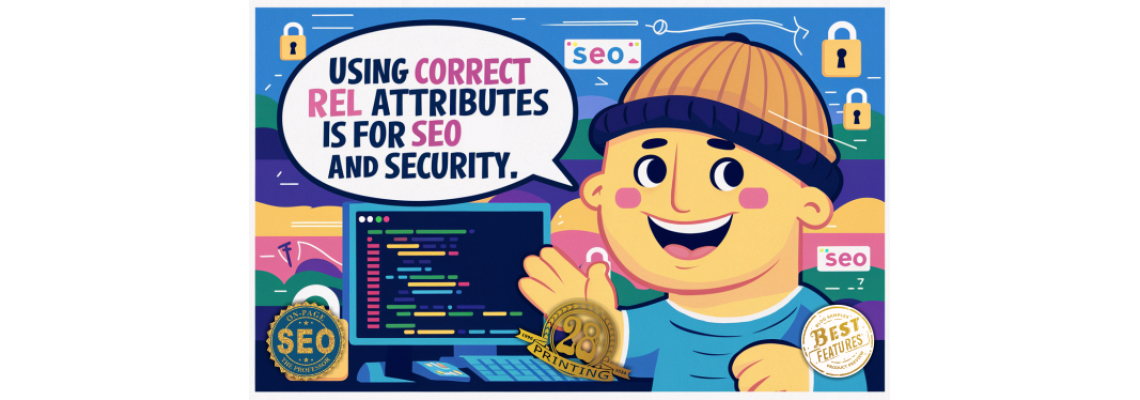09 Aug


The rel attribute in HTML is used to define the relationship between the current document and the linked resource.
It is commonly used in anchor (<a>) tags but can also be found in other tags like <link>. Here's a detailed explanation of when and where you should use various rel tags, focusing on nofollow, noopener, and noreferrer.1. rel="nofollow"
When to Use:
- Untrusted Content or Links: If you are linking to a website that you do not fully trust or are unsure about its content, use
rel="nofollow"to prevent passing any link equity (SEO value) to that site. - Sponsored Content: When linking to sponsored or paid content (e.g., advertisements, affiliate links), use
rel="nofollow"to comply with Google's guidelines, as these links should not influence search engine rankings. - User-Generated Content: For links in user-generated content (like blog comments, forums, or guest posts), using
rel="nofollow"helps prevent the abuse of link building strategies (e.g., spammy backlinks).
Why Use:
- SEO: Search engines like Google may not follow or pass any "link juice" to links marked with
nofollow, so it helps maintain the integrity of your site's link profile. - Avoid Manipulation: Prevents any attempt by external sites to manipulate your website's ranking by adding untrusted or low-quality links.
2. rel="noopener"
When to Use:
- Opening Links in a New Tab/Window: When you use
target="_blank"to open a link in a new tab or window, you should also addrel="noopener".
Why Use:
- Security: Without
rel="noopener", the new page has access to thewindow.openerproperty, which can be exploited to manipulate the original page (e.g., changing its location via JavaScript). - Performance: Preventing the
window.openerconnection can also lead to better performance by avoiding unnecessary memory usage.
3. rel="noreferrer"
When to Use:
- Privacy: If you do not want the referring site (your site) to be known by the destination site (the site you are linking to), use
rel="noreferrer". This can be useful for privacy concerns or to avoid sending referral data.
Why Use:
- Security and Privacy: Like
noopener,noreferreralso prevents the new page from accessingwindow.opener, but it additionally prevents the browser from sending the HTTPRefererheader, which contains the URL of the linking page. - Combine with noopener: It's common to see
rel="noopener noreferrer"together to achieve both security (nowindow.opener) and privacy (noRefererheader).
4. rel="ugc"
When to Use:
- User-Generated Content: Use
rel="ugc"for links that appear in user-generated content, such as comments, forums, or posts created by users.
Why Use:
- Distinguishing Content: Helps search engines understand that these links are from user-generated content, which may carry different trust levels.
5. rel="sponsored"
When to Use:
- Sponsored or Paid Links: For links that are part of a sponsorship, advertisement, or other paid arrangements.
Why Use:
- Transparency and Compliance: Ensures that search engines know these links are paid or sponsored, helping you comply with advertising and SEO guidelines.
Common Use Cases:
Blogging:
- External links in blog posts:
rel="nofollow" - Affiliate links:
rel="sponsored nofollow" - Links in user comments:
rel="ugc nofollow"
- External links in blog posts:
E-commerce Sites:
- Partner or affiliate product links:
rel="sponsored" - External resources or references:
rel="noopener noreferrer"(especially if opening in a new tab)
- Partner or affiliate product links:
Forums or Social Platforms:
- Links in user profiles, comments, or posts:
rel="ugc nofollow"
- Links in user profiles, comments, or posts:
Web Development:
- Internal navigation links: Typically no
relneeded, but considernoopenerwhen usingtarget="_blank". - Outbound links to untrusted sources:
rel="nofollow noreferrer"
- Internal navigation links: Typically no
Conclusion
Using the correct rel attributes is essential for both SEO and security. nofollow is crucial for managing link equity, while noopener and noreferrer protect against potential security risks and enhance privacy. By understanding and applying these attributes appropriately, you can better control how search engines interact with your links and how users' data is handled when they navigate away from your site.

Leave a Comment